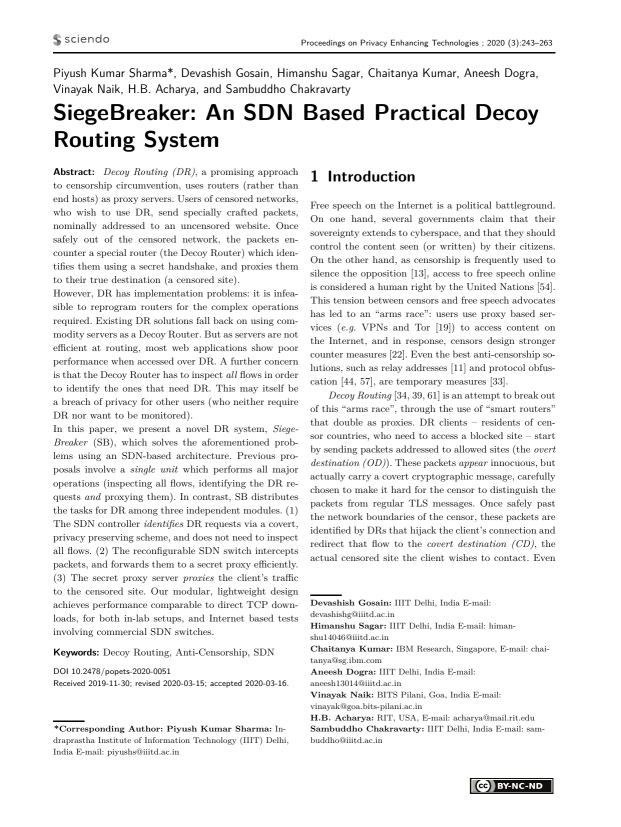SiegeBreaker: An SDN Based Practical Decoy Routing System
Authors: Piyush Kumar Sharma (Indraprastha Institute of Information Technology (IIIT) Delhi, India), Devashish Gosain (IIIT Delhi, India), Himanshu Sagar (IIIT Delhi, India), Chaitanya Kumar (IBM Research, Singapore), Aneesh Dogra (IIIT Delhi, India), Vinayak Naik (BITS Pilani, Goa, India), H.B. Acharya (RIT, USA), Sambuddho Chakravarty (IIIT Delhi, India)
Volume: 2020
Issue: 3
Pages: 243–263
DOI: https://doi.org/10.2478/popets-2020-0051
Abstract: Decoy Routing (DR), a promising approach to censorship circumvention, uses routers (rather than end hosts) as proxy servers. Users of censored networks, who wish to use DR, send specially crafted packets, nominally addressed to an uncensored website. Once safely out of the censored network, the packets encounter a special router (the Decoy Router) which identifies them using a secret handshake, and proxies them to their true destination (a censored site). However, DR has implementation problems: it is infeasible to reprogram routers for the complex operations required. Existing DR solutions fall back on using commodity servers as a Decoy Router. But as servers are not efficient at routing, most web applications show poor performance when accessed over DR. A further concern is that the Decoy Router has to inspect all flows in order to identify the ones that need DR. This may itself be a breach of privacy for other users (who neither require DR nor want to be monitored). In this paper, we present a novel DR system, SiegeBreaker (SB), which solves the aforementioned problems using an SDN-based architecture. Previous proposals involve a single unit which performs all major operations (inspecting all flows, identifying the DR requests and proxying them). In contrast, SB distributes the tasks for DR among three independent modules. (1) The SDN controller identifies DR requests via a covert, privacy preserving scheme, and does not need to inspect all flows. (2) The reconfigurable SDN switch intercepts packets, and forwards them to a secret proxy efficiently. (3) The secret proxy server proxies the client’s traffic to the censored site. Our modular, lightweight design achieves performance comparable to direct TCP downloads, for both in-lab setups, and Internet based tests involving commercial SDN switches.
Keywords: Decoy Routing, Anti-Censorship, SDN
Copyright in PoPETs articles are held by their authors. This article is published under a Creative Commons Attribution-NonCommercial-NoDerivs 3.0 license.

